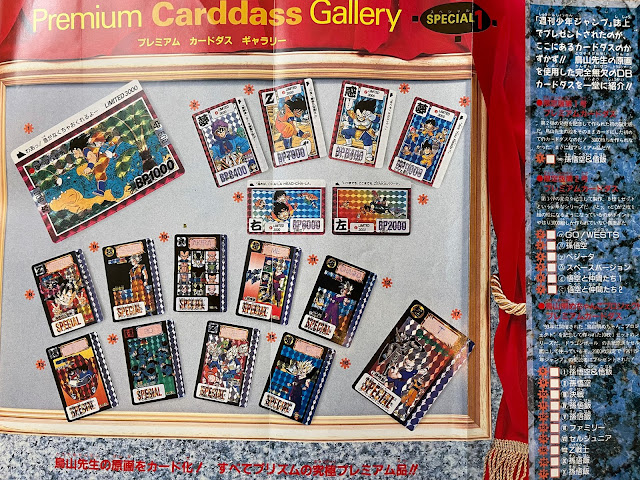 |
| Limited Carddass cards displayed at Mandarake in 2018 |
The purpose of this blog will be to cover the limited cards from the "classic" era of Dragon Ball Carddass cards.
I love the main series of Carddass, Super Battle, Visual Adventure, PP and such just as much as the limited cards. However as mentioned in the introduction page there are already great sites covering main series Dragon Ball cards, but the Limited gift cards that Bandai offered are generally only given brief mentions.
Among enthusiasts and collectors there is a lot of fascination for the rare and limited Carddass cards, but to my surprise most collectors do not know or understand the history of these cards all that well. This is why I decided to make this blog.
I'm American of Japanese descent and a nearly life long Dragon Ball fan
as I grew up watching the original Dragon Ball series starting in the
late 80's during the Japanese broadcasting when I was still a little
child. I collected Japanese Dragon Ball cards throughout most of the
90's and resumed again in the 2000's.
My goal will be to cover the limited cards of Dragon Ball Carddass. Starting with the First Limited 3000 card from 1989, all the way to the Tokubetsudan B-course Limited card from 1998. Many people spend hundreds (sometimes even thousands) on these cards without really knowing much about them. Hopefully this blog can serve the purpose of spreading information on these cards.
So what are the limited cards? Mostly they were presents (or gifts) from Weekly Shonen Jump & Bandai to the fans either through raffle rewards, rewards for participating at events, or rewards for high scores at tests.
Here's a brief introduction to these cards.
 |
| Premium Carddass Gallery Special 1 |
The 1995 Daizenshuu Carddass Perfect File volume 1 showcases almost all of the limited gift cards (of those released prior to publication) in several special page spreads across the pages of the book.
The first spread at the start of the book called the "Premium Carddass Gallery Special 1" covers the most iconic 3 Limited sets: The first Limited card, the second set of 6 Limited 3000 cards, and the set of 10 Toriyama Akira Mechanko Project limited cards.
This spread is a foldout type, and includes a checklist for readers to mark off the ones they have. This is also done on the other "Gallery" pages as well.
 |
| Premium Carddass Gallery 2 |
The second Premium Carddass Gallery Special 2 continues the list of limited Carddass cards, starting with the Ultimate Exhibit 1994 invitation card (number 1), the Over 1 Billion Carddass Commemoration set of 5 prisms (numbers 2 through 6), the Ultimate Exhibit 1995 admission card (number 7), and the Jump Museum '92 Son Goku card (number 8). The last three pictured (numbers 9, 10, 11) are limited Jumbo and Super Jumbo cards.
Please note that limited cards released after the release of the book
are of course not included. These cards are: The GT card n0 "Son Goku
and friends", The "Movie Special 1995" prism card, the "n1000 release
celebration Limited 3D" gift card (a 3D holo card), and the two
"Tokubetsudan" limited gift cards.
A couple other gift cards not mentioned in the book but that had been
released at the time of publication are the set of two 25th anniversary Jump Multi World 1993 prism cards. As they featured characters from many manga they were not exclusively Dragon Ball
cards (probably why they were not included), but since Dragon
Ball is featured most prominently (with Goku center stage on one card, and Gohan center stage on the other),
they are generally viewed as Dragon Ball Carddass limited gift cards as well.
 |
| Premium Goods Gallery |
The "Premium Goods Gallery" are items related to Carddass that are other than cards. At the moment in this blog I don't intend to cover the limited Jumbo cards or the Carddass Goods.
Despite not being cards these premium items are mostly very limited gifts. They include The Commemorative Card (100 made). This is one of the most prestigious Carddass goods items. It is shaped like a card, but is actually a gold colored metal plaque. It is both much thicker and heavier than Carddass cards. It comes in a special see-through protective display case.
Other items include the Carddass clock (30 made), the Carddass tapestry (300 made), the Limited Gold Keyholder (800 made?), and the extremely limited Carddass 20 part set Ingot case (the book mistakenly states 24 parts). The Ingot case contained the Ultimate Exhibit version of part 20 which includes the two deluxe versions of the 2 reversible prisms of part 20, which were limited to this event (only 25 made).
Not pictured but there also exists a Super Battle 14 part Complete Box, and a Carddass 24 part Complete Box presents also given out in extremely limited quantities at the Ultimate Exhibit 1995.


